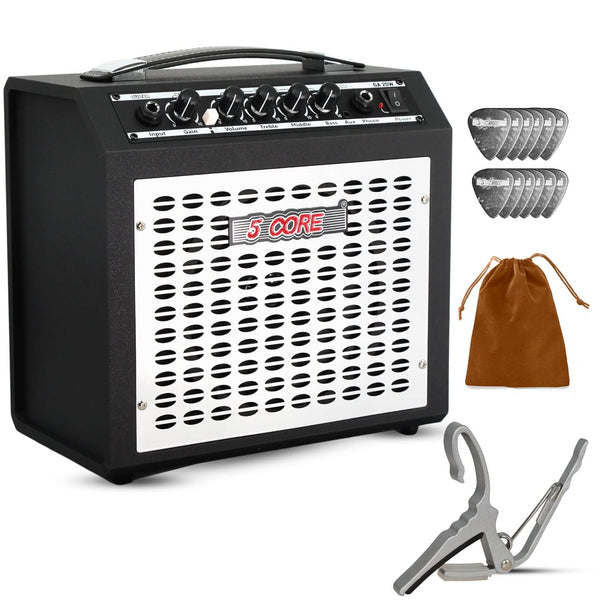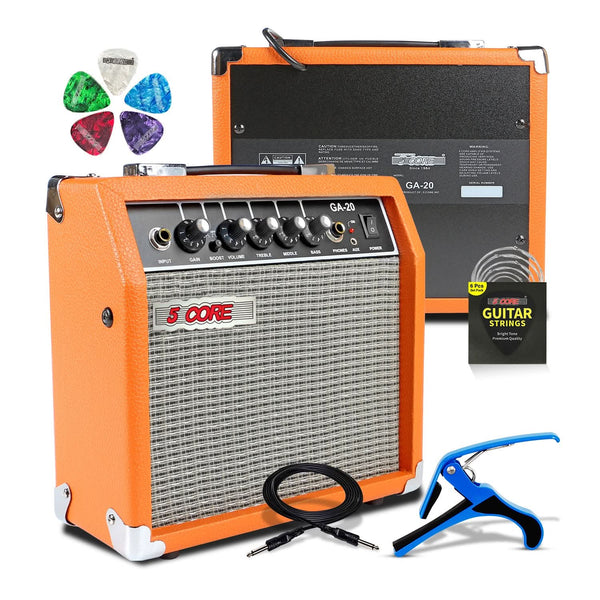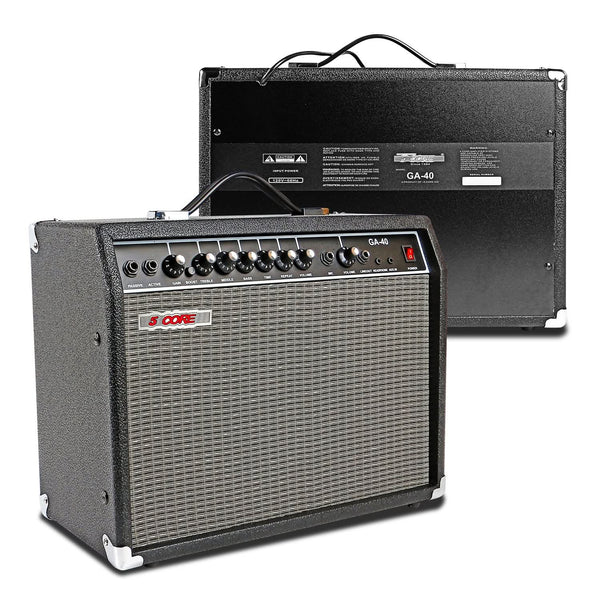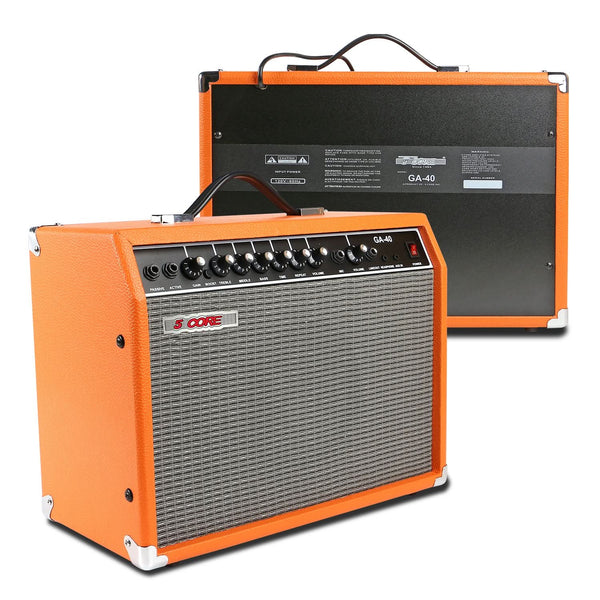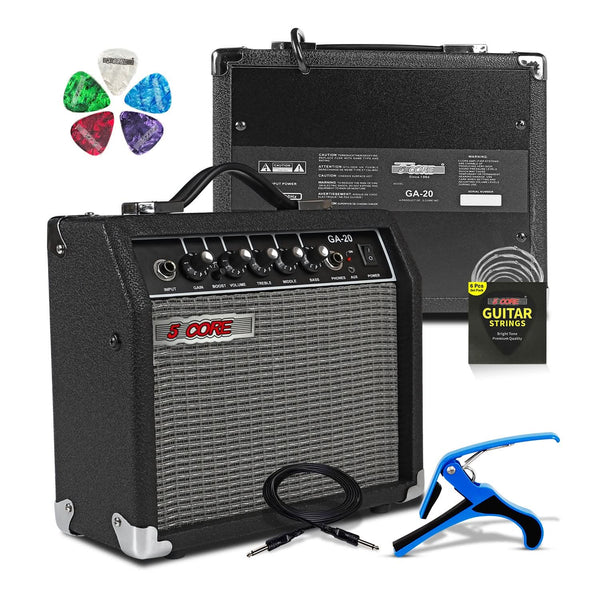
The Complete Guide to Guitar & Bass Amplifiers:
Shopping for a guitar amp, bass amp, or electric guitar amp can feel overwhelming. With countless blog posts, YouTube videos, and forum threads offering conflicting advice, it's no wonder most players end up confused. Whether you're looking for a mini amp for bedroom practice or a bass guitar amp for live performances, understanding what really matters will save you time, money, and frustration.
Introduction: Why 90% of Guitar Amp Advice on the Internet Is Wrong in 2025
Here's the uncomfortable truth: most online amp recommendations are based on outdated assumptions, affiliate commissions, or what worked for someone else's specific needs—not yours. The typical advice focuses on brand names and wattage numbers without context, leading players to buy amps that are either too powerful for their needs or too limited for their ambitions.
The real issue? Context matters more than specifications. A 100-watt tube amp sitting in your bedroom at conversation volume sounds completely different than that same amp cranked at a venue. A bass electric guitar amp typically requires 300-500 watts as a good median, while guitar amps can work well at much lower wattages.
Modern mini amplifiers and mini guitar amps have revolutionized practice scenarios, but online reviews often fail to distinguish between what works for bedroom practice versus what's suitable for rehearsals or gigs. The key is understanding your actual use case before diving into technical specifications.
Guitar Amp Wattage Reality Check: How Loud Is Loud Enough?
The Wattage Myth That Won't Die
One of the biggest misconceptions in the guitar world is that wattage equals volume in a linear way. The loudness difference between a 50-watt amp and a 100-watt amp is only 3 decibels (dB), which is not really a drastic difference.
Here's what actually matters:
For Home Practice:
-
For home use your amp should be around 20W
-
A mini amp at 5-10 watts is perfectly adequate for bedroom practice
-
Many modern practice amps include power scaling features
Gigging with a Band:
-
If you're playing with a drummer, you'll likely need a 100W solid state amp, or a 50W valve amp
-
A 50- to 90-watt tube amplifier is gig-worthy and ideal for hard rock, metal, and shred-style guitarists
For Large Venues:
-
For arena tours and extra-loud bands, you'll want a 100-plus-watt tube guitar amplifier
Tube vs. Solid-State Volume
Tube amps are simply louder than their solid state counterparts - a 10-watt tube amp will likely keep up with a blues or rock drummer just fine, while a solid state amp that's 10 watts will go completely unheard.
Speaker Efficiency Matters More Than You Think
Speaker efficiency is expressed in decibels (dB), and a lower-efficiency speaker will be quieter than a higher-efficiency speaker, even if each speaker is being powered by an identical amplifier with identical settings. A speaker with a sensitivity of 90dB will take twice the amplifier power to be the same volume as another speaker rated at 93 dB efficiency.
Sources:
How to Buy a Guitar Amp and Avoid Rookie Mistakes
Mistake #1: Ignoring Your Playing Environment
The biggest purchasing error? Buying an oversized volume monster you'll never use properly - unless you're headlining the local stadium or live in the middle of nowhere, you simply aren't likely to need 100 watts of raging amplifier behind you.
Smart Approach:
-
Define where you'll play 90% of the time
-
Choose wattage based on that primary use
-
Consider power scaling or attenuator options for versatility
Mistake #2: Not Testing with Your Own Guitar
Bring your main guitar with you - an unfamiliar guitar may have a brighter sound than your personal ax, and an amp that sounded sparkly and lively in the store may actually be dull with your instrument.
Mistake #3: Confusing Gain with Volume
Many guitarists confuse gain with volume - gain is nothing more than input sensitivity, and overdoing it won't give you more power, but rather a muddy, compressed sound.
Mistake #4: Focusing Only on Brand Names
Unless you're a bone fide super-fan buying guitar amplifier as some form of musical pilgrimage to your hero, aim to get a rig that sounds how you want it to sound - you'll never quite sound as good as the artist no matter how much money you spend on identical gear.
Mistake #5: Buying for "Someday" Instead of Today
Ask yourself whether you're buying an amp you can use immediately in the way you envisaged, or if you're buying something you can look longingly at knowing one day you'll use it.
What to Consider:
-
Music style: Different genres require different tonal characteristics
-
Portability: Will you transport this regularly?
-
Features: Built-in effects, headphone jacks, recording outputs
-
Budget: Quality matters more than quantity of features
Sources:
Bass Guitar Amplifier vs Guitar Amp: Can You Use One for Both in 2025?
The Critical Differences
Power Requirements: Basses produce lower frequencies which require more power - low-end notes need more oomph to get that deep, rich sound, so bass electric guitar amp are typically built to handle more wattage. It's not unusual for bass electric guitar amp to be 300, 400 or even 800 watts.
Frequency Response: Guitars play around in the mid-range, with their true tone between 200 Hz and 7 kHz, while bass guitars eat up a lot more low-end and less high-end, living more comfortably between 30 Hz and 2kHz.
Speaker Design: Bass amps have much bigger magnets in the speakers which push air and help the sound resonate, producing a louder sound while being able to handle the more aggressive frequency response.
Can You Actually Swap Them?
Guitar Through Bass Electric Guitar Amp: A guitar through a bass electric guitar amp will sound very dull as there are missing frequencies from the highs and mid areas that a guitar amp will have, but the good news is it is very unlikely you will damage it greatly.
Bass Through Guitar Amp: At low volumes, guitar speakers will work OK with bass, but at higher volumes, the lower frequencies of a bass will tend to destroy most guitar speakers. If you were to turn up the volume you might blow the speaker and damage the electronics in the amp.
The Exception to the Rule
If you plug a passive bass into a big guitar amplifier, you can get some amazing sounds - Lemmy from Motörhead created his signature sound by playing a Rickenbacker Bass through a distorted Marshall. However, this is the exception, not the rule, and requires specific equipment and knowledge.
Sources:
The Truth About "Practice Amps That Double as Gig Amps"
Can Practice Amps Really Gig?
The modern amp market has blurred these lines significantly. Modern tech means that many practice amps can also be used for gigging and sound good at low or high volumes.
Truly Gig-Capable Practice Amps: The 5 Core 80W brings more flexibility, more effects control, and external footswitch compatibility—making it the most gig-capable practice amp out there.
The Reality Check
Most practice guitar amplifier aren't powerful enough for gigging - there are quite a few modern amps that hit 50 or 100 watts though, which will be fine for gigging.
What Actually Works:
-
50-watt modeling amps with power scaling
-
Amps with direct outputs for PA systems
-
Tube amps 20 watts and above (with microphone support)
What Doesn't:
-
Sub-20 watt solid-state amps without PA support
-
Mini amplifiers designed solely for desktop use
-
Battery-powered portable amps
The Compromise Solution: Many gigging musicians use smaller practice amps with direct outputs or microphones, allowing them to maintain their tone while the PA system handles volume. This approach gives you the best of both worlds without compromising portability.
Sources:
Speaker Break-In: Myth vs Reality
What the Science Says
This topic generates heated debate, but the evidence is clear: Speaker break-in is no myth and something significant really does happen - the mechanical properties of a speaker are slightly modified once a speaker is put into service, and the tone is affected by these changes.
What Actually Changes
The components making up the speaker's suspension—the spider (lower suspension) and the cone surround (upper suspension)—begin losing some of their initial stiffness, resulting in an increase in overall warmth, slightly deeper/fatter lows, and warmer/smoother highs.
Scientific testing shows that the bottom fills out, the resonant frequency lowers about 20hz, the treble is not as sharp and the mids fill out.
How Long Does It Take?
Subtle changes will continue throughout the life cycle of the speaker, but the most noticeable amount occurs in the early stages of use. Most players report noticeable differences between 10-50 hours of playing time.
The Myth Part
Here's what ISN'T true about speaker break-in:
-
A poor sounding speaker will not sound better once you run it in for a few hours - if you don't like the speaker as soon as you put it in, you will probably never like it
-
Break-in won't transform a mediocre speaker into a great one
-
Aggressive break-in methods can damage speakers
How to Break In Speakers Properly
The best way is to play your amp with fat, clean tone, turn up the power amp volume to full, and control the level with the preamp gain at a quite loud but not painful level for at least an hour.
The expert advice is that you should break your speakers in slowly so they don't prematurely wear out - plug in, turn up, and rock out.
Sources:
Most Common Guitar Amp Failures & How to Avoid Them Forever
The Real Failure Frequency
Based on professional repair experience, amp problems occur in this order: tubes, cables and connections, transducers and mechanical parts (speakers, jacks, pots, reverb tanks), electronic components, then transformers.
Problem #1: Tube Failures (Most Common)
Tubes are wearing parts - depending on use, preamp tubes can last several years, but power amp tubes last much shorter, especially if you run them hot or never let them cool down.
Warning Signs:
-
Sound becomes thinner over time
-
Dynamics diminish
-
Sudden noise or hum appears
-
Complete loss of sound
Prevention:
-
Replace tubes at first signs of degradation
-
Using the standby switch allows tubes to reach necessary operating temperature before playing, protecting the inner workings
-
Don't overdrive preamp excessively
Problem #2: Bad Connections and Dirty Contacts
Defects often occur in potentiometers, connectors, or contacts, typically only when a potentiometer is moved, a plug is touched, or a fader is used - corroded contacts are the most common cause.
Prevention:
-
In effects loops where contacts become dirty or oxidized, cycle a plug in and out 8–10 times so contacts open and close, then leave plugs inserted so contacts can dry properly
-
Use contact cleaner annually
-
Exercise all switches and pots regularly
Problem #3: Speaker and Cable Issues
With a "no sound" symptom, the amplifier electronics could be working fine, but the sound has nowhere to go - unplug the speaker(s) and connect an alternate speaker using an alternate speaker cable.
Prevention:
-
Inspect speaker cables regularly for damage
-
Check speaker cone condition
-
Ensure proper impedance matching
Problem #4: Gain Mismanagement
Constantly overdriving the preamp can lead to thermal problems - tubes run hot, generate unnecessary noise, become microphonic, or give up the ghost long before their time.
Prevention:
-
Find your amp's "sweet spot" for gain settings
-
Use pedals for distortion instead of maxing preamp gain
-
Balance gain, volume, and EQ properly
Problem #5: Environmental Factors
Even an amplifier in perfect working condition can malfunction if placed in the wrong environment, such as being plugged into a poorly filtered outlet or placed next to sources of interference.
Prevention:
-
Use power conditioners in problematic venues
-
Keep amps away from phones, routers, fluorescent lights
-
Maintain proper ventilation
-
Store in climate-controlled environments
The One Thing That Rarely Fails
Output transformers very rarely fail - in about 200 amps repaired per year, maybe one or two output transformer failures occur. If someone immediately blames your transformer without proper diagnosis, get a second opinion.
Sources:
Final Recommendations for 2025
For Bedroom Practice
Look for mini amps or mini guitar amps between 5-20 watts with:
-
Headphone outputs
-
USB recording capabilities
-
Power scaling options
-
Quality tone at low volumes
For Band Rehearsals
Consider:
-
30-50 watt tube amps
-
50-100 watt solid-state amps
-
Modeling amps with adequate power sections
-
Direct outputs for additional flexibility
For Bass Players
A dedicated bass electric guitar amp is essential:
-
Minimum 100 watts for practice with band
-
300-500 watts for most gigging situations
-
Proper speaker configuration (10", 12", or 15" speakers)
-
Closed-back cabinet design
For Gigging Musicians
Invest in:
-
50-100 watt tube amps (guitar)
-
300-500 watt amps (bass)
-
Quality speakers that can handle the power
-
Reliable cables and backup tubes
Remember: The best amp is the one that fits YOUR specific needs, not what worked for someone else. Test equipment with your own instrument, in environments similar to where you'll actually play, and prioritize tone and reliability over brand prestige or excessive features.
The Top 10 Most Asked Guitar Amp FAQs
1. What's the difference between a tube amp and a solid-state amp?
-
Tube Amps: Sound warmer and "break up" naturally when turned up loud. Loved for their classic, responsive tone but are heavier, more expensive, and need maintenance (tube replacement).
-
Solid-State Amps: Reliable, affordable, and sound clean at any volume. Great for beginners and players who need a consistent sound.
2. What do "Gain" and "Volume" do?
-
Gain: Controls the amount of distortion or overdrive. Turn it up for a crunchy or lead tone.
-
Volume/Master: Controls the overall loudness of the amp. This lets you have a distorted tone at a lower volume.
3. How many watts do I actually need?
-
Bedroom Practice: 5-20 watts is plenty. Lower wattage amps sound better at low volumes.
-
Band Practice/Gigs: 20-50 watts (or more) to compete with a drummer. Higher wattage means more clean headroom (stays clean when loud).
4. What is a combo amp vs. a head and cabinet?
-
Combo: The amplifier and speaker are in one box. Convenient and all-in-one.
-
Head & Cab: Separate units. The "head" is the amplifier, and the "cab" (cabinet) is the speaker box. Offers more flexibility to mix and match.
5. What is an FX Loop, and do I need one?
-
It's a loop for your effects pedals that places them after the preamp distortion. It's essential for keeping time-based effects like delay and reverb clear and pristine, especially with a distorted tone.
6. Why does my amp hum or buzz?
-
Normal: A slight hum with high gain settings or single-coil pickups.
-
Trouble: A loud buzz or crackling can be a bad cable, a failing tube (in a tube amp), or interference from other electronics.
7. Can I play my electric guitar without an amp?
-
Yes, but it will be very quiet. You can use a multi-effects pedal with a headphone output, a computer interface, or a small headphone amp for silent practice.
8. What do the EQ knobs (Bass, Middle, Treble) do?
-
They shape the tone. Bass = low end (thump), Treble = high end (brightness), Middle = the crucial frequencies that help your guitar cut through a band mix.
9. My amp has two channels. What does "channel switching" mean?
-
It means you can switch between different pre-set sounds, typically a Clean Channel and a Drive/Distortion Channel, often with a footswitch.
10. Can I use a guitar amp for bass or vocals?
-
No. Guitar amps are not designed for the low frequencies of a bass and can be easily damaged. They are also not suited for the full frequency range of a microphone or vocals. Always use the correct amp for the instrument.
About 5core
At 5 Core, we understand that finding the right amplifier requires balancing quality, features, and value. Whether you're searching for your first guitar amplifier, upgrading your bass electric guitar amp
Our range includes everything from compact mini amplifiers perfect for home practice to full-featured stage-ready systems. Each product in our guitar amp collection is selected based on real-world performance, not just specifications on paper.
Browse our guitar amplifier collection to find the perfect amp for your needs, backed by expert support and competitive pricing.
Author Bio-
Alex Even
Hi, I’m Alex Even. I’ve been working in the pro audio industry for over 15 years, specializing in everything from studio recording setups to live sound systems. Whether it’s fine-tuning a PA DJ system, choosing the right microphone, drum stool, keyboard bench or setting up a home studio, karaoke setup, I’ve spent years helping musicians, audio engineers, and content creators get the sound they’re looking for. I’m passionate about making audio technology easy to understand and even easier to use—because great sound should be accessible to everyone




